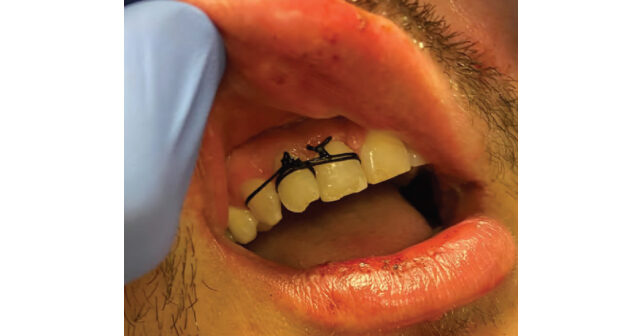
Case Summary
A 32-year-old male presented after a fall from standing. He had a right lateral incisor (tooth number 7) avulsion and presented with his tooth in hand. It had not been stored in any liquid media prior to arrival at the emergency department. Emergency department (ED) staff placed the tooth in milk until evaluation by the treating physician. The tooth was then reapproximated by placing it back into the socket and two 2-0 silk sutures were tied around neighboring teeth to anchor the tooth (Figure 1). The patient was discharged with a course of antibiotics and dental referral.
Explore This Issue
ACEP Now: Vol 41 – No 11 – November 2022Discussion
Avulsed permanent teeth are a true dental emergency and represent up to 11 percent of all cases of dental trauma.1 The International Association of Dental Traumatology recommends immediate first aid in the setting of an avulsed permanent tooth. This includes handling the avulsed tooth by the crown only (to avoid touching the root and to minimize contamination), washing in cold running water to remove loose debris, and immediate reimplantation, if possible, in a conscious patient.2 Otherwise, the guidelines recommend placement in a suitable solution to prevent drying of the root of the tooth. In order of decreasing preference, the guidelines recommend milk, Hanks, Balanced Salt Solution, saliva (have the patient spit into a clean container), or saline. Water is not recommended but is better than leaving the tooth to air dry. Dry time should be less than 60 minutes to prevent loss of viability of periodontal ligament cells.
After the patient comes to the ED, the physician can attempt re-implantation and flexible splinting to secure the tooth until definitive dental care can be obtained. Local anesthesia may be needed to facilitate re-implantation. In a study of three different methods—periodontal pack, wire, and bondable reinforcement ribbon—to secure an avulsed tooth in the emergency department, dentists preferred the bondable reinforcement ribbon technique for optimal long-term outcomes.3 Alternative methods, including using tissue adhesive bonded to the pliable metal from a non-rebreather mask, or nylon fishing wire bonded with composite materials, have also been described.4,5
After splinting, the physician should verify the normal position of the re-implanted tooth both clinically and radiographically. A flexible splint should remain in place for up to two weeks. Update tetanus protection in the ED, if necessary. Prescribe the patient a course of oral antibiotics and use a chlorhexidine (0.1 percent) mouth rinse twice a day for one week. Patients should also be advised to avoid participation in contact sports, to consume a soft diet for up to two weeks, and to brush teeth with a soft toothbrush after meals.
Pages: 1 2 | Single Page






One Response to “A Novel Technique to Treat a Dental Avulsion”
November 13, 2022
Kenneth V. Iserson, MDAny non-dentist attempting to replace avulsed teeth will be justifiably nervous. Even in a well-equipped ED, working in a small space and doing a novel procedure can be challenging; a remote setting is even more problematic. It behooves the clinician to use the simplest possible methods. While Dr. Dark and colleagues describe one method on interdental stabilization using sutures (previously described), it is, as they note, not the easiest and probably not the most successful technique.
Using cyanoacrylate (Superglue or the equivalent) may be the easiest and best makeshift method. After drying the affected tooth and the adjacent teeth and gums, apply the adhesive to the teeth and to the gingiva below them. Apply the adhesive to both the mesial (closest to mid-line) and distal (away from midline) sides of the tooth so that it bonds to the adjacent teeth. Even better is to combine adhesive and a wire that can be the metal bridge from a surgical mask, a thin orthopedic wire; a small-gauge spinal needle with the ends clipped; a thin paperclip; or similar thin-gauge, malleable, but relatively rigid, wire. Bend the wire so it conforms to the convexity of the normal tooth configuration and covers four or five teeth (more if the technique is used to stabilize and mandibular or maxillary fracture).[1]
All these methods are only temporizing. The patient should be placed on a liquid or soft diet and be seen by a dental professional as soon as possible.
[1] Iserson KV: Dental: Fillings, Extractions, and Trauma, In: Improvised Medicine: Providing Care in Extreme Environments, 2nd ed. McGraw-Hill Publishing, New York, NY. 2016:440-442.